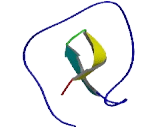Anosmin 1 (ADMLX)
[Edit]KAL1; KAL; KALIG-1; Kallmann syndrome protein; Adhesion molecule-like X-linked

KAL protein is N-glycosylated, secreted in the cell culture medium, and localized at the cell surface.Several lines of evidence indicated that heparan-sulfate chains of proteoglycan(s) are involved in the binding of the KAL protein to the cell membrane.
The protein is synthesized by definite neuronal cell populations, including Purkinje cells in the cerebellum, mitral cells in the olfactory bulbs, and several subpopulations in the optic tectum, and the striatum. The protein, with an approximate molecular mass of 100 kD, was named anosmin-1 by the authors in reference to the deficiency of the sense of smell that characterizes Kallmann disease. Anosmin-1 was thought to be an extracellular matrix component. Since heparin treatment of cell membrane fractions from cerebellum and tectum resulted in the release of the protein,
Organism species: Homo sapiens (Human)
| CATALOG NO. | PRODUCT NAME | APPLICATIONS | |
| Proteins | RPP933Hu01 | Recombinant Anosmin 1 (ADMLX) | Positive Control; Immunogen; SDS-PAGE; WB. |
| Antibodies | PAP933Hu01 | Polyclonal Antibody to Anosmin 1 (ADMLX) | WB; IHC; ICC; IP. |
| Assay Kits | n/a | CLIA Kit for Anosmin 1 (ADMLX) | CLIA Kit Customized Service Offer |
| n/a | ELISA Kit for Anosmin 1 (ADMLX) | ELISA Kit Customized Service Offer |
- "The candidate gene for the X-linked Kallmann syndrome encodes a protein related to adhesion molecules."Cell 67:423-435(1991) [PubMed] [Europe PMC] [Abstract]
- "Structure of the X-linked Kallmann syndrome gene and its homologous pseudogene on the Y chromosome."Nat. Genet. 2:305-310(1992) [PubMed] [Europe PMC] [Abstract]
- "A gene deleted in Kallmann's syndrome shares homology with neural cell adhesion and axonal path-finding molecules."Nature 353:529-536(1991) [PubMed] [Europe PMC] [Abstract]
- "The DNA sequence of the human X chromosome." Nature 434:325-337(2005) [PubMed] [Europe PMC] [Abstract]
- "The status, quality, and expansion of the NIH full-length cDNA project: the Mammalian Gene Collection (MGC)."Genome Res. 14:2121-2127(2004) [PubMed] [Europe PMC] [Abstract]
- "Characterization of the promoter of the human KAL gene, responsible for the X-chromosome-linked Kallmann syndrome."Gene 164:235-242(1995) [PubMed] [Europe PMC] [Abstract]
- "The Kallmann syndrome gene product expressed in COS cells is cleaved on the cell surface to yield a diffusible component."Hum. Mol. Genet. 5:1109-1115(1996) [PubMed] [Europe PMC] [Abstract]
- "Initial characterization of anosmin-1, a putative extracellular matrix protein synthesized by definite neuronal cell populations in the central nervous system."J. Cell Sci. 109:1749-1757(1996) [PubMed] [Europe PMC] [Abstract]
- "Anosmin-1, defective in the X-linked form of Kallmann syndrome, promotes axonal branch formation from olfactory bulb output neurons."Cell 109:217-228(2002) [PubMed] [Europe PMC] [Abstract]
- "Novel mechanisms of fibroblast growth factor receptor 1 regulation by extracellular matrix protein anosmin-1."J. Biol. Chem. 284:29905-29920(2009) [PubMed] [Europe PMC] [Abstract]
- "Extended and flexible domain solution structure of the extracellular matrix protein anosmin-1 by X-ray scattering, analytical ultracentrifugation and constrained modelling."J. Mol. Biol. 350:553-570(2005) [PubMed] [Europe PMC] [Abstract]
- "Heterogeneity in the mutations responsible for X chromosome-linked Kallmann syndrome."Hum. Mol. Genet. 2:373-377(1993) [PubMed] [Europe PMC] [Abstract]
- "Genetic heterogeneity evidenced by low incidence of KAL-1 gene mutations in sporadic cases of gonadotropin-releasing hormone deficiency."J. Clin. Endocrinol. Metab. 82:213-217(1997) [PubMed] [Europe PMC] [Abstract]
- "A recurrent missense mutation in the KAL gene in patients with X-linked Kallmann's syndrome."J. Clin. Endocrinol. Metab. 83:1650-1653(1998) [PubMed] [Europe PMC] [Abstract]
- "The importance of autosomal genes in Kallmann syndrome: genotype-phenotype correlations and neuroendocrine characteristics."J. Clin. Endocrinol. Metab. 86:1532-1538(2001) [PubMed] [Europe PMC] [Abstract]
- "The product of X-linked Kallmann's syndrome gene (KAL1) affects the migratory activity of gonadotropin-releasing hormone (GnRH)-producing neurons."Hum. Mol. Genet. 13:2781-2791(2004) [PubMed] [Europe PMC] [Abstract]
- "Clinical assessment and mutation analysis of Kallmann syndrome 1 (KAL1) and fibroblast growth factor receptor 1 (FGFR1, or KAL2) in five families and 18 sporadic patients."J. Clin. Endocrinol. Metab. 89:1079-1088(2004) [PubMed] [Europe PMC] [Abstract]
- "Kallmann syndrome: 14 novel mutations in KAL1 and FGFR1 (KAL2)."Hum. Mutat. 25:98-99(2005) [PubMed] [Europe PMC] [Abstract]
- "Kallmann syndrome: mutations in the genes encoding prokineticin-2 and prokineticin receptor-2."PLoS Genet. 2:1648-1652(2006) [PubMed] [Europe PMC] [Abstract]
- "Clinical assessment and molecular analysis of GnRHR and KAL1 genes in males with idiopathic hypogonadotrophic hypogonadism."Clin. Endocrinol. (Oxf.) 66:173-179(2007) [PubMed] [Europe PMC] [Abstract]
- "KAL1 mutations are not a common cause of idiopathic hypogonadotrophic hypogonadism in humans."Mol. Hum. Reprod. 13:165-170(2007) [PubMed] [Europe PMC] [Abstract]
- "A fertile male patient with Kallmann syndrome and two missense mutations in the KAL1 gene."Fertil. Steril. 95:1789-1792(2011) [PubMed] [Europe PMC] [Abstract]
- "Identification of two novel missense mutations in the KAL1 gene in Han Chinese subjects with Kallmann Syndrome."J. Endocrinol. Invest. 34:53-59(2011) [PubMed] [Europe PMC] [Abstract]
- "SEMA3A, a gene involved in axonal pathfinding, is mutated in patients with Kallmann syndrome." PLoS Genet. 8:E1002896-E1002896(2012) [PubMed] [Europe PMC] [Abstract]
- "Mutations in FGF17, IL17RD, DUSP6, SPRY4, and FLRT3 are identified in individuals with congenital hypogonadotropic hypogonadism." Am. J. Hum. Genet. 92:725-743(2013) [PubMed] [Europe PMC] [Abstract]
- "The prevalence of CHD7 missense versus truncating mutations is higher in patients with Kallmann syndrome than in typical CHARGE patients." J. Clin. Endocrinol. Metab. 99:E2138-2143(2014) [PubMed] [Europe PMC] [Abstract]
